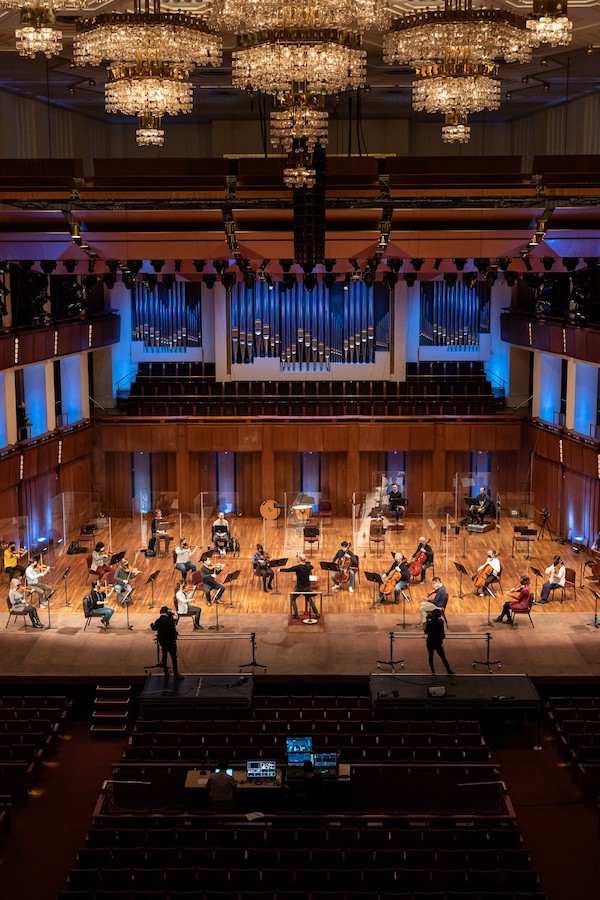After year of lockdown, Noseda makes welcome virtual return to NSO podium

Cast your mind back to last March. The National Symphony Orchestra had cancelled its concert tour of Asia—first the appearances in China and then the remainder of the tour in Japan—because of a novel coronavirus circulating in those countries. Images appeared on the news of cities and entire countries shut down, and all residents and travelers wearing masks over their faces.
Little did we know then what the future would hold. Within a few weeks of those tour cancellations in February, health authorities would declare Covid-19 a global pandemic. The Kennedy Center closed its doors, initially just for the month of March. The ensuing silence has lasted far longer than any of us likely thought, leading the Kennedy Center to eventually cancel all live events through this summer.
A ray of hope appeared earlier this month, when NSO music director Gianandrea Noseda returned to Washington from his home in Italy. The orchestra had managed to avoid a controversial furlough by renegotiating its contract with the Kennedy Center last year. Now Noseda is conducting four concerts this month, to be recorded in the Concert Hall and streamed online. The first of these virtual programs, recorded on March 6, was released last night.
The program opened with the First Symphony by Joseph Bologne, Chevalier de Saint-Georges (1745-1799). He was born on the island of Guadeloupe, the son of a French planter and an enslaved woman of African descent. Young Joseph moved to Paris with his mother, both of them given their freedom by his father. During the French Revolution he fought for the Republic as colonel of the Légion Saint-Georges, the first all-black regiment in Europe.
Equally talented with the violin as the saber, Bologne began to perform in François Gossec’s orchestra for Le Concert des Amateurs, a concert series in Paris. He eventually became Gossec’s concertmaster, composing many violin concertos for himself to play in that ensemble. When Gossec took over Le Concert Spirituel in 1773, Bologne became the leader of Le Concert des Amateurs.
The rediscovery of Bologne’s music was already under way in recent years. Now that orchestras are actively seeking ways to include black composers in their repertoire, we are likely to hear his symphonies and violin concertos even more. The First Symphony is a light affair, a reminder of the genre’s origins as pleasing music meant to divert noble ears. Its three movements encompass only about a dozen minutes, but it provides plenty of entertainment along the way.
Melodic interest remains almost solely with the violin section, the two oboes and two horns merely reinforcing crescendi and louder sections. Spread apart by social distancing, the strings remained impressively consolidated in this piece, the first movement spritely and dancing. The second movement, an Andante serenade for strings only, was particularly charming. The third movement made for a bubby conclusion.
A strong contrast came with the Valse triste, drawn from Sibelius’s incidental music for Kuolema (Death), a play by Arvid Järnefelt, brother of Sibelius’s wife. This piece is heard during the play when the main character, Paavali, falls asleep at the deathbed of his mother. She rises to dance with a group of shadowy dancers, and Death appears at the door. In the morning she is dead. Noseda and the orchestra captured the mysterious qualities of the music, alluring and yet unsettling.
The concert ended on a perennial favorite with Mozart’s Symphony No. 40. Ensemble unity was most challenging in this work for a larger orchestra. The winds and brass, separated by space and plexiglass shields, sometimes seemed as a group to be just slightly off rhythmically from their string counterparts. The microphones sometimes captured individual instruments oddly, especially on the bass side of the texture.
Even with these minor reservations, this performance was a bittersweet reminder of the delights of the concert hall. Noseda led decisively, with tempo choices that accentuated the excitement of the outer movements and the suave refinement of the second movement, where the strings played with special warmth and purity of tone. The Menuet tramped weightily, while the trio returned to the spirit of that lovely second movement. The finale pulsed with energy and grace, with lovely solo moments from principal clarinetist Lin Ma and other wind players.
This concert can be streamed online through April 19. The next two NSO programs will be released through the Kennedy Center Digital Stage on April 15. kennedy-center.org
